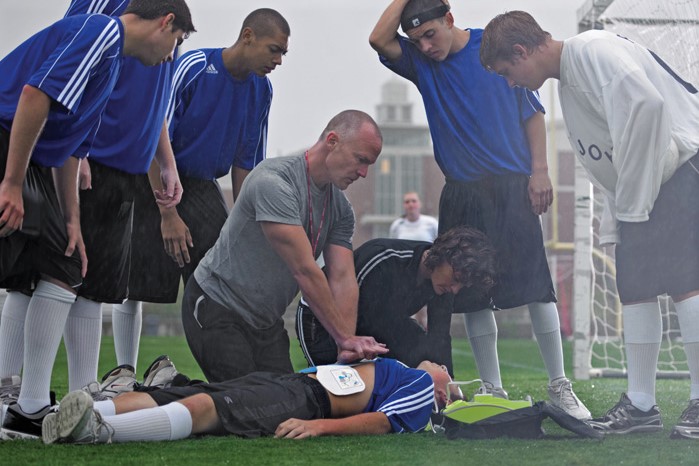
Why Sports Coaches Need First Aid Training
Sports coaches’ responsibilities mainly revolve around ensuring athletes’ health and safety while pushing them to be at their best
These will require a thorough understanding of basic first aid and lifesaving from the sidelines.
The life of sports coaches can vary, making it more challenging
Aside from developing the talents of individual athletes, you are also involved in injury prevention and treatment, on and off the play area.
Hence, it is important to focus on the vital role of sports coaches in first aid safety, whether you are a football coach, a track and field specialist, or a match official.
Common Sports-Related Injuries
Sports injuries are a common occurrence at all levels of competition, and some may require immediate medical attention.
Injuries are likely to happen whether it involves school activities, collegiate-level athletics, or professional games.
The good news is that most injuries in the field are treatable and not fatal.
Estimates show that only two per cent of sports injuries require hospitalisation, and athletes don’t need to go on a trip to the emergency room.
In most cases, sports injury treatment starts with the application of basic first aid and simple urgent care options.
First Aid Treatment for Sports Injuries: the role of coaches
Common sports injuries such as sprains, strains, and minor fractures can be stabilised with basic preventative methods, including:
A) Bleeding
Bleeding injuries such as cuts and scrapes are common in any sport.
However, there is a chance that blood becomes infectious.
In this case, the athlete must be removed from the game or practice until the bleeding is controlled and wounds are clean and covered.
B) Fractures
Severe fractures, if left untreated, can affect the bone’s ability to grow over time which is vital, especially for young athletes.
In the case of fractures in the upper leg area, seek professional help right away.
This can be life-threatening and requires medical attention, especially if the injury is within the femoral artery.
C) Sprains and strains
Sprains and strains are not considered medical emergencies, but these soft tissue injuries can be painful.
Most soft tissue injuries are treatable using the RICE treatment – rest, ice, compressions, and elevation.
If there is any doubt about the injury, always treat it as fractures until proven otherwise by an X-ray.
D) Heat exhaustion and heat stroke
Health exhaustion and heat stroke are serious medical emergencies that are preventable during sporting events.
The increased body temperature and the body’s inability to get rid of the heat can happen due to dehydration and loss of electrolytes.
Prevention is the key to preventing these serious heat illnesses.
Athletes should remain hydrated by drinking plenty of water and taking breaks on hot days.
First aid treatment is aimed at cooling the athlete down.
Common interventions include removing clothing, applying cool water to the skin, and placing ice packs on different body parts.
When in doubt about the seriousness of any injury, always seek professional help. The doctor can evaluate whether they should be allowed to return to the game or leave the facility.
Athletes with significant injuries are not permitted to return to the game without a medical release from a healthcare professional.
First Aid Training for Sports Coaches
All sports coaches wants a winning team while having a healthy and safe one.
As their mentor, it is your job to teach athletes how to play their chosen sports to the best of their ability.
At the same time, you must keep them safe while doing it. And first aid is a vital part of sports safety.
Read Also:
Emergency Live Even More…Live: Download The New Free App Of Your Newspaper For IOS And Android
Let’s Talk About Ventilation: What Are The Differences Between NIV, CPAP And BIBAP?
Emergency Live Even More…Live: Download The New Free App Of Your Newspaper For IOS And Android
Drowning Resuscitation For Surfers
First Aid: When And How To Perform The Heimlich Maneuver / VIDEO
Mild, Moderate, Severe Mitral Valve Insufficiency: Symptoms, Diagnosis And Treatment
First Aid, The Five Fears Of CPR Response
Perform First Aid On A Toddler: What Differences With The Adult?
Heimlich Maneuver: Find Out What It Is And How To Do It
Respiratory Arrest: How Should It Be Addressed? An Overview
How To Manage A Prehospital Burn?
Irritant Gas Inhalation Injury: Symptoms, Diagnosis And Patient Care
Chest Trauma: Clinical Aspects, Therapy, Airway And Ventilatory Assistance
Internal Haemorrhage: Definition, Causes, Symptoms, Diagnosis, Severity, Treatment
Introduction To Advanced First Aid Training
First Aid Guide For The Heimlich Manoeuvre
Temporal And Spatial Disorientation: What It Means And What Pathologies It Is Associated With
Concussion: What It Is, What To Do, Consequences, Recovery Time
Emergency Rescue: Comparative Strategies To Exclude Pulmonary Embolism
Pneumothorax And Pneumomediastinum: Rescuing The Patient With Pulmonary Barotrauma
Barotrauma Of The Ear And Nose: What It Is And How To Diagnose It
Clinical Review: Acute Respiratory Distress Syndrome
Stress And Distress During Pregnancy: How To Protect Both Mother And Child
Respiratory Distress: What Are The Signs Of Respiratory Distress In Newborns?
Sepsis: Survey Reveals The Common Killer Most Australians Have Never Heard Of
Sepsis, Why An Infection Is A Danger And A Threat To The Heart
Respiratory Distress Syndrome (ARDS): Therapy, Mechanical Ventilation, Monitoring
The Australian Government: How To Perform Cardiopulmonary Resuscitation? / VIDEO
Emergency Room: How Long You Should Stay Awake After A Head Injury


